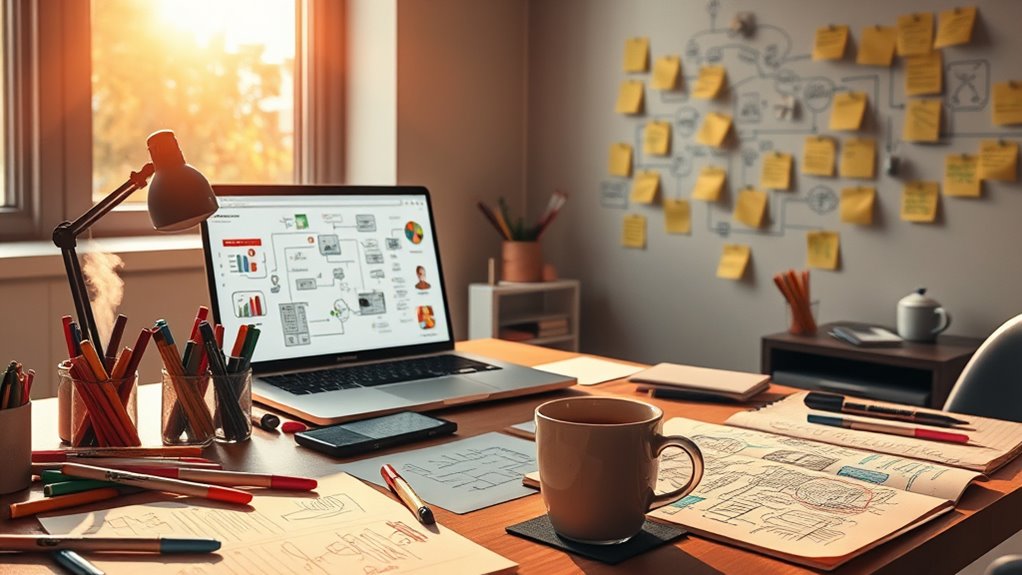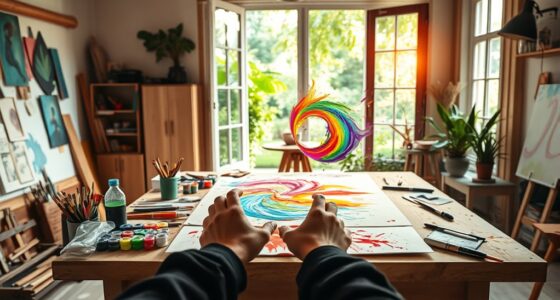When creative blocks strike, you can break through in just 15 minutes using quick activity triggers. Try rapid sketching or visual brainstorming to spark new ideas visually, or do free writing to tap into your subconscious without judgment. Incorporate sensory explorations or movement breaks to reset your energy, or use constraints to challenge yourself creatively. Focused exercises like mind mapping or reflective journaling can also open fresh perspectives—keep exploring these flow triggers to reignite your inspiration.
Key Takeaways
- Use rapid sketching and visual brainstorming to generate multiple ideas quickly, bypassing mental blocks.
- Engage senses with tactile exploration or quick physical activities to reset focus and stimulate creativity.
- Set a 15-minute timer for a focused perspective shift, prioritizing tasks and limiting distractions to enhance clarity.
- Incorporate unrelated ideas or constraints to challenge assumptions and foster innovative thinking within short bursts.
- Experiment with changing styles, tools, or environments abruptly to break routines and spark fresh creative flow.
Rapid Sketching to Unlock Visual Ideas
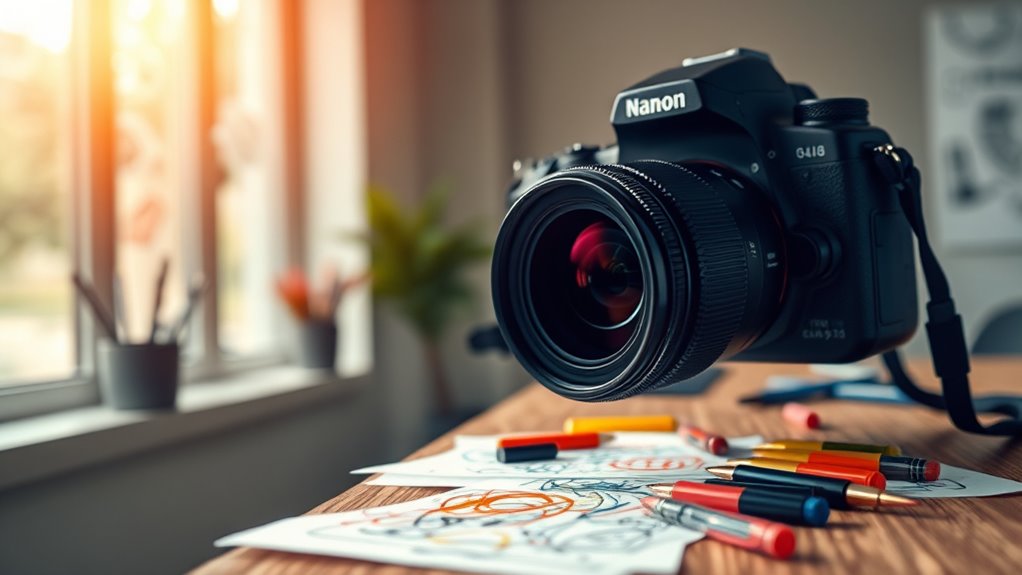
When you’re feeling stuck on visual ideas, rapid sketching can be a powerful tool to break through creative barriers. It encourages visual brainstorming by allowing you to quickly translate concepts onto paper without overthinking. This process helps you engage your subconscious, sparking new perspectives and connections. Focus on idea rapidization—drawing swiftly to capture the essence of your ideas rather than perfect details. As you sketch rapidly, you’ll generate multiple options, pushing past mental blocks and opening up fresh creative pathways. Keep your hand moving freely, and don’t censor yourself. This technique fosters spontaneity and helps you visualize ideas more clearly, ultimately boosting your creative flow and making your design process more fluid and dynamic. Additionally, embracing energetic alignment can further amplify your creative potential by aligning your mindset with your artistic goals.
Free Writing Without Judgment

Free writing without judgment involves letting your thoughts flow freely onto the page without filtering or editing them. It’s a simple way to tap into your subconscious, much like mindfulness meditation helps quiet your mind. As you write, don’t worry about spelling, grammar, or coherence—just let ideas surface naturally. Creative journaling during this process encourages honesty and openness, removing self-censorship. This practice helps you bypass mental blocks and fosters spontaneous insights. By focusing on the act of writing rather than the quality, you create a safe space for inspiration to emerge. Regularly practicing free writing without judgment can boost your creativity, improve clarity, and make it easier to develop fresh ideas with ease and confidence. Incorporating mental well-being techniques like mindfulness can further enhance your ability to access your creative flow.
Mind Mapping for Quick Concept Connections
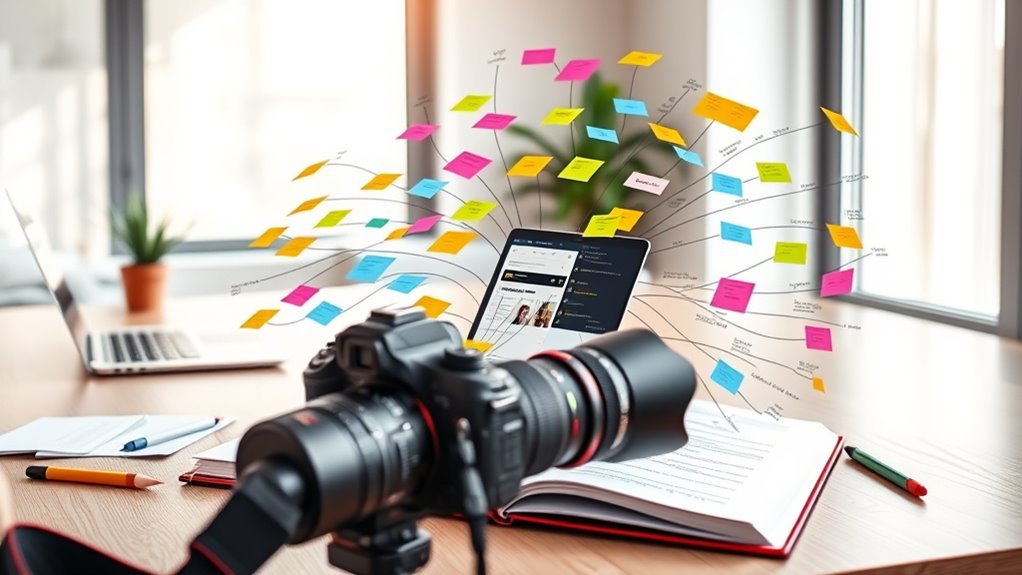
Mind mapping is a dynamic tool that helps you quickly connect ideas and organize thoughts visually. When you use mind mapping for quick connections, you tap into your brain’s natural way of associating concepts. To maximize its effectiveness, keep these tips in mind:
Mind mapping enhances quick idea connections by visually organizing thoughts and triggering natural associations.
- Start with a central idea, and branch out with related concepts.
- Use keywords and short phrases for clarity.
- Color-code branches to distinguish themes easily.
- Keep the map flexible—add, remove, or rearrange ideas as needed.
- Incorporating sound healing science into your mind map can inspire innovative ways to enhance relaxation and well-being.
This approach accelerates your thinking process, making it easier to see relationships and generate new insights rapidly. Mind mapping streamlines idea flow, allowing you to make quick concept connections and boost your creative momentum.
Rapid Object Collage Creation
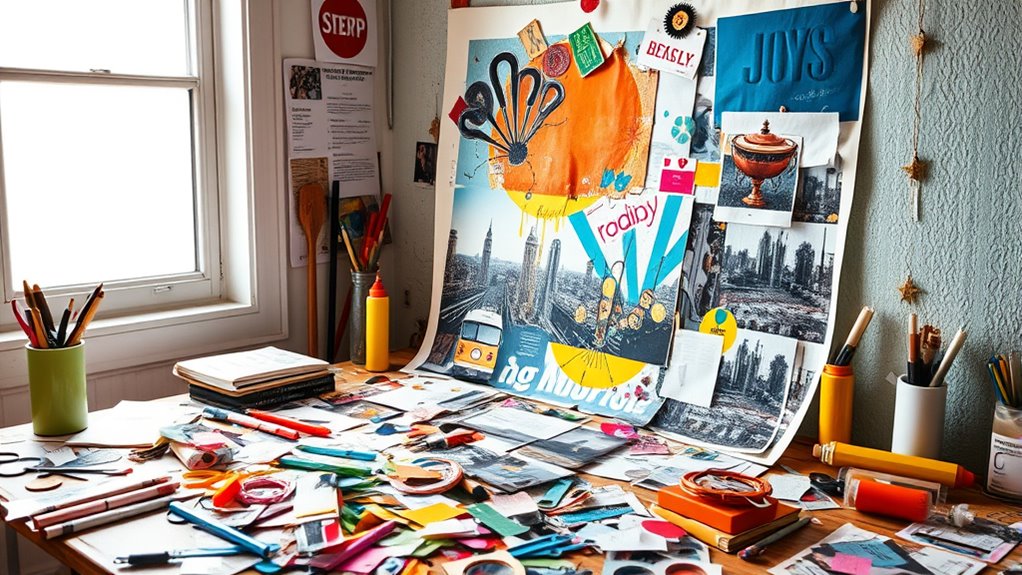
Creating a rapid object collage is a quick and effective way to generate visual ideas and inspire creativity. As you gather diverse images, you tap into your visual memory, releasing associations and hidden connections. Focus on contrasting colors and harmonious color schemes based on color theory to make your collage vibrant and engaging. Use objects that evoke strong emotions or memories, helping you access deeper ideas. Keep your selections spontaneous—don’t overthink—allowing your subconscious to guide you. The process encourages you to see relationships between shapes, textures, and colors, sparking new perspectives. This exercise not only boosts your creative flow but also trains your eye to notice details quickly, making it a powerful tool for breaking through creative blocks efficiently. Additionally, engaging in visual memory exercises can enhance your ability to recognize patterns and associations, further amplifying your creative potential.
Sensory Exploration Exercise

Have you ever considered engaging your senses directly to open fresh creative insights? The sensory exploration exercise invites you to do just that, sharpening your sensory perception through tactile engagement. To start, find five everyday objects with different textures. Then, for each item:
- Close your eyes and touch it slowly.
- Notice the texture, temperature, and weight.
- Describe what you feel aloud or in your mind.
- Repeat with the remaining objects, focusing on each detail.
This practice heightens your awareness of sensory input, revealing new perspectives. By immersing yourself in tactile engagement, you bypass mental filters, fostering spontaneous creative ideas. It’s a quick, powerful way to reset your mind and spark inspiration in just minutes. Incorporating sensory techniques from voiceover and storytelling practices can further enhance your creative flow.
Timed Brainstorming With a Single Word
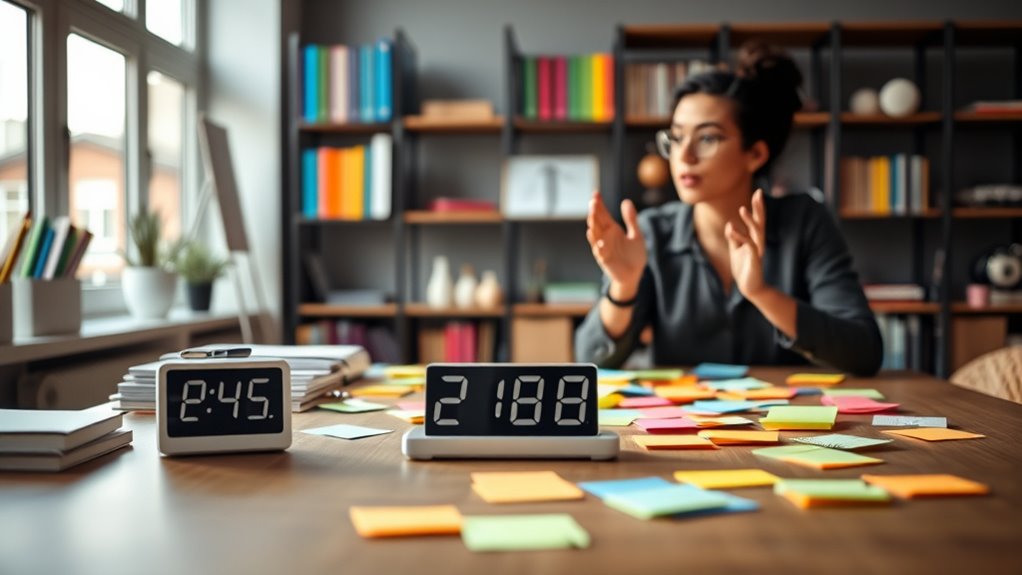
Timed brainstorming with a single word is a powerful technique to reveal fresh ideas quickly. You choose a single word related to your project or challenge, then set a timer for 10-15 minutes. During this time, focus solely on generating ideas connected to that word, without self-criticism or editing. This approach boosts your idea generation by forcing rapid, unfiltered thinking, often revealing unexpected solutions. It also enhances your creative confidence, encouraging you to trust your intuitive insights. By limiting your focus and time, you reduce overthinking and create a sense of urgency that sparks creativity. This simple yet effective method keeps your mind agile, helping you break through mental blocks and discover new angles in a short burst of focused effort.
Doodling in a Different Style

Try experimenting with new mediums like watercolor or digital tools to change how your doodles feel. Mix unrelated elements, such as geometric shapes with organic forms, to spark fresh ideas. Alter your drawing style by mimicking different artists or genres to break out of your usual routine. Additionally, exploring entertainment support hours can inspire new themes or techniques by engaging with online tutorials and resources during off-peak times.
Experiment With New Mediums
Ever considered how doodling in a different style can spark fresh creativity? Experimenting with new mediums opens up exciting possibilities for visual storytelling. When you try mixed media, you challenge your usual approach and push boundaries. Incorporating sound design techniques into your creative process can further enhance your work by adding depth and emotional resonance. Here’s how to get started:
- Choose a new medium—watercolors, ink, collage, or digital tools.
- Mix different materials to create textured, layered effects.
- Focus on expressing emotion or narrative, not perfection.
- Use these experiments to discover unique visual language.
Combine Unrelated Elements
Have you ever thought about how combining unrelated elements in your doodles can spark unexpected creativity? During collaborative brainstorming sessions, try mixing objects or symbols from different worlds—like blending a cityscape with organic shapes. Use themed mind maps to explore these juxtapositions, connecting seemingly unrelated ideas to inspire fresh visuals. By doodling in a style that’s different from your usual approach, you challenge your brain to think beyond familiar patterns. This process encourages hybrid imagery, where a robot might have floral wings or a mountain could transform into a giant eye. The key is to let spontaneity lead you, breaking free from conventional boundaries and opening new pathways for creative expression. Incorporating visual harmony can help balance the chaotic mix of elements, making your doodles more cohesive. Combining unrelated elements fuels innovation and keeps your doodling lively.
Alter Your Drawing Style
Mixing unrelated elements in your doodles encourages experimentation, but changing your drawing style takes that creativity further. To do this, focus on altering key aspects like color theory and line weight. Here are four ways to shift your style:
- Use contrasting colors to create bold visual effects.
- Vary line weight to add depth and emphasis.
- Experiment with different color palettes—monochrome, complementary, or analogous.
- Adopt new techniques, such as hatching or stippling, to change texture and tone.
These adjustments challenge your usual approach and push your creative boundaries. By consciously playing with color theory and line weight, you can develop a fresh, unique style that keeps your doodles exciting and dynamic. Remember, the goal is to explore and enjoy the process. Embracing attention during your practice can significantly enhance your ability to innovate and refine your style.
Setting a 15-Minute Timer for a New Perspective
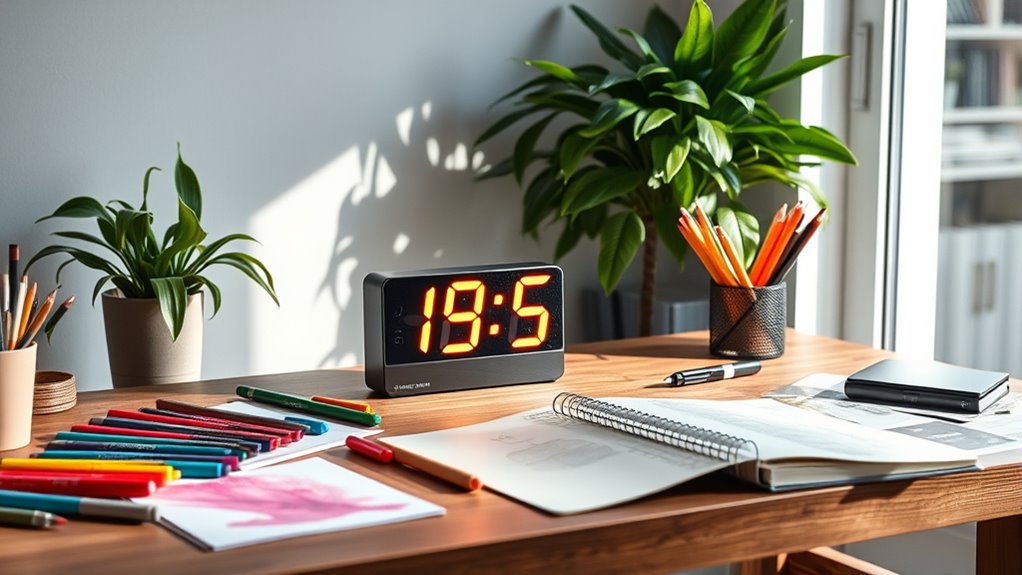
Setting a 15-minute timer encourages you to embrace short timeframes that spark quick, fresh ideas. It helps you see your work from a new perspective without overthinking, keeping your creativity flowing. By doing this regularly, you’ll boost your momentum and stay inspired to create. Incorporating time-limited challenges like this can also enhance your ability to adapt quickly during juice cleanses or detox routines, making it easier to stick to your goals and stay motivated.
Embrace Short Timeframes
When you allocate just 15 minutes to a creative task, you force yourself to focus intensely and avoid overthinking. Short timeframes sharpen your time management skills and help you set clear goals quickly. This approach prevents perfectionism and encourages rapid progress. To maximize this method:
- Prioritize your task to stay goal-oriented.
- Set a strict timer to create urgency.
- Limit distractions to maintain focus.
- Review your progress briefly before moving on.
Embracing short timeframes pushes you to act, making ideas more concrete and less paralyzed by doubt. It trains your mind to work efficiently within tight constraints, boosting productivity and clarity. This simple shift in perspective can *access* fresh, innovative solutions you might overlook in longer sessions.
Cultivate Fresh Perspectives
To break free from habitual thinking and discover fresh ideas, challenge yourself to view your project from a new angle within just 15 minutes. Set a timer and practice mindful observation, intentionally shifting your perspective. This simple exercise activates your creativity, fostering clarity and openness. To inspire emotion and engagement, consider how different viewpoints can transform your approach:
| Frame of Mind | New Angle | Unexpected Insight |
|---|---|---|
| Empathy | Walk in their shoes | Hidden motivations |
| Curiosity | Ask “what if” | Alternative solutions |
| Skepticism | Question assumptions | Overlooked details |
| Optimism | Visualize success | Fresh motivation |
| Past Experiences | Connect lessons learned | Unique ideas |
Boost Creative Momentum
A quick, focused 15-minute timer can instantly boost your creative momentum by encouraging you to adopt a fresh perspective. During this time, you’re more likely to push past hesitation and foster creative confidence through artistic experimentation. To maximize this, try:
- Switching mediums — explore a new art form or tool to spark innovation.
- Changing your environment — move to a different space to inspire fresh ideas.
- Limiting your options — set constraints to challenge your creativity.
- Focusing on process over perfection — prioritize experimentation, not final results.
These strategies help you break free from mental blocks, deepen your artistic confidence, and keep your creative momentum flowing. A simple timer transforms how you approach your work, making each session a catalyst for new perspectives.
Quick Meditation to Clear the Mind
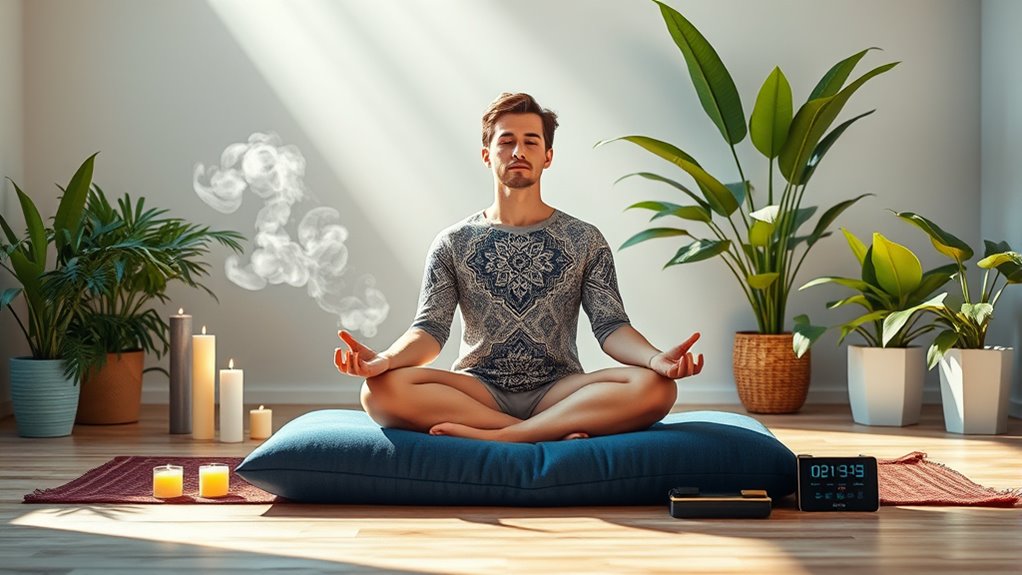
If your mind feels overwhelmed and cluttered, a quick meditation can provide instant clarity. Start with a simple mindfulness practice: sit comfortably, close your eyes, and focus on your breath. Use breathing techniques like deep inhales through your nose and slow exhales through your mouth to center yourself. As you breathe, let go of racing thoughts and bring your attention to the present moment. This quick meditation helps reset your mental state, clearing mental fog and reducing stress. Even just a few minutes of focused breathing can create space for fresh ideas and renewed focus. Incorporate this practice whenever you need a fast mental reset, boosting your creativity and productivity with minimal effort.
Random Word Association Challenge

The Random Word Association Challenge is a dynamic exercise that sparks creativity by encouraging quick, spontaneous connections between words. As you engage, you practice mindful reflection, staying aware of your thought process without judgment. This challenge helps loosen mental blocks and boosts idea generation. To maximize its benefits:
- Pick a random word quickly—don’t overthink.
- Say or write the first word that comes to mind, embracing spontaneous association.
- Reflect briefly on how the two words connect, noticing your thought patterns.
- Repeat with a new word, maintaining speed and openness.
This exercise sharpens your ability to connect ideas swiftly and intuitively, fostering fresh perspectives. It’s an effective way to break mental rigidity and invite creative flow through spontaneous association and mindful reflection.
Short Improv Storytelling Session

Jump into a short improv storytelling session where your imagination takes center stage. Use simple storytelling techniques like starting with a character or setting, then building the plot spontaneously. Improv exercises such as “Yes, and” encourage you to accept and expand on ideas, keeping the story flowing naturally. Focus on staying present and trusting your instincts—don’t worry about perfection. These quick sessions help break mental clutter and spark creativity in minutes. As you improvise, you’ll develop your storytelling skills, learn to think on your feet, and *access* new ideas. Keep it playful and light—there’s no need for structure or editing. Just let your imagination run wild and enjoy the process of creating a compelling story in real-time.
Quick Movement or Stretch Break for Inspiration
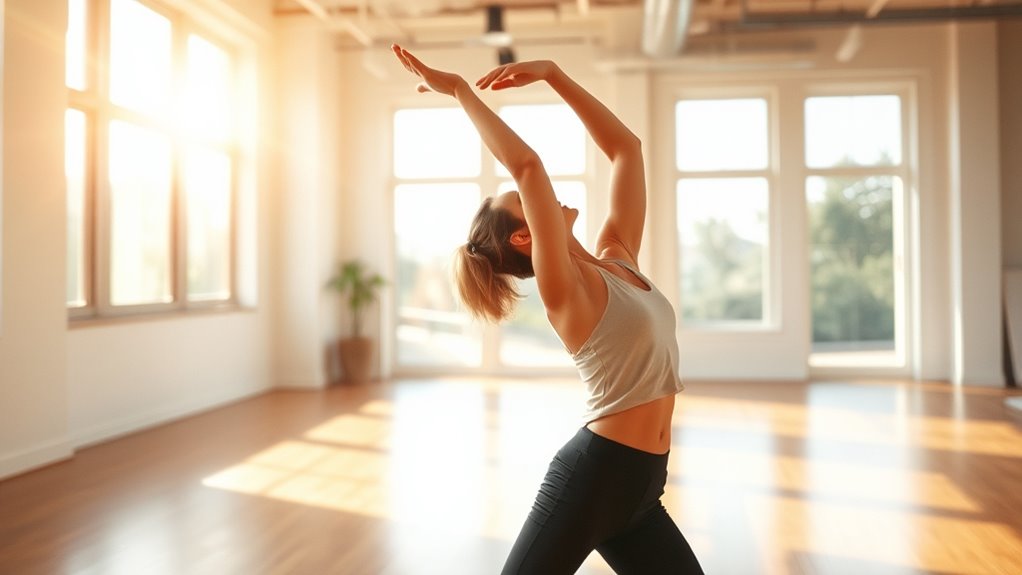
Taking a quick stretch or doing some light cardio can spark your creativity when you’re feeling stuck. Simple routines like arm circles or brisk walking get your blood flowing and clear your mind. These small movements might be just what you need to unseal fresh ideas.
Energizing Stretch Routines
When creative energy stalls, a quick stretch can work wonders to reignite your inspiration. Focus on mindful breathing as you stretch, syncing your breath with movement to enhance energy alignment. This simple routine boosts circulation and clears mental clutter, helping you return refreshed. Try these energizing stretches:
- Reach overhead and stretch side to side, breathing deeply.
- Roll your shoulders back to release tension.
- Twist your torso gently to engage core muscles.
- Stretch your neck with slow, deliberate movements.
Keep your movements intentional, focusing on breath and body awareness. These quick routines activate your energy flow, making it easier to access fresh ideas and stay inspired during your creative block. Just a few minutes can reset your mind and body for ideal flow.
Quick Cardio Boost
A quick burst of cardio can do wonders for reigniting your creative fire. Moving your body briefly boosts your circulation, delivering fresh oxygen and nutrients to your brain. These cardio benefits help clear mental fog, sharpen focus, and spark new ideas. When you feel stuck, taking just a few minutes for jumping jacks, jogging in place, or a brisk walk can provide the quick energy you need to break through creative blocks. This simple activity stimulates your nervous system, increasing alertness and motivation. Plus, it’s easy to fit into any schedule—no equipment required. Whether you have five or ten minutes, a quick cardio boost primes your mind for inspiration, making it easier to tackle your next project with renewed clarity and enthusiasm.
Listening to a New Genre of Music

Listening to a new genre of music can open your mind to fresh sounds and perspectives you might have never encountered before. It’s a simple yet powerful way to stimulate your creativity and break mental blocks. When you explore different genres, you engage in genre discovery, which can unleash new ideas and emotional insights. This practice also aligns with music therapy principles, helping you relax or energize your mind. To maximize this flow trigger, consider these steps:
- Choose a genre you’re unfamiliar with.
- Play music without distractions.
- Focus on the different instruments and rhythms.
- Reflect on how it makes you feel and think.
This approach keeps your mind flexible, paving the way for innovative thinking and creative breakthroughs.
Using Constraints to Spark Creativity
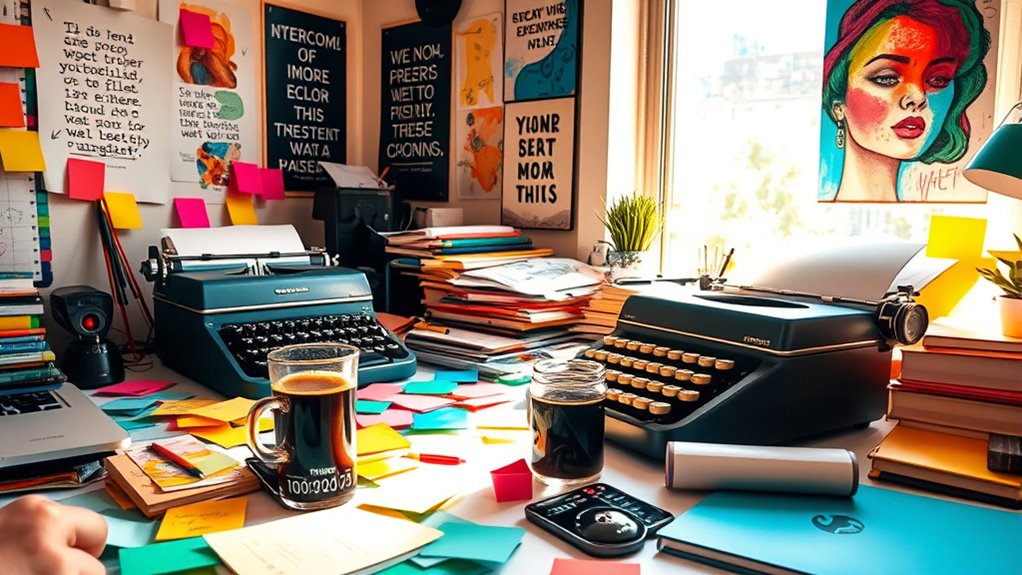
Have you ever noticed how limitations can actually boost your creative output? Constraints force you into constraint-based thinking, which sparks innovative solutions. By setting boundaries, you challenge yourself to think differently and push your limits with boundary pushing techniques. These constraints don’t stifle; they *release* your creativity by narrowing options, making you focus sharply. Try applying a rule: create a story without using the letter “e” or design within a fixed color palette. To visualize, here’s a quick guide:
| Constraint Type | Example | Benefit |
|---|---|---|
| Word Limit | 100-word story | Sharpens focus, encourages brevity |
| Material Restriction | Only use recycled materials | Boosts resourcefulness |
| Time Limit | 15-minute sketch | Promotes quick thinking |
| Concept Boundaries | No traditional tools | Inspires novel approaches |
Reflective Journaling on a Single Prompt

Reflective journaling on a single prompt encourages you to explore deeply into your thoughts and feelings without distraction. This practice boosts your journaling discipline and enhances emotional awareness by focusing your attention. To maximize benefits, consider these tips:
Deepen your emotional awareness and journaling discipline through focused, single-prompt reflection.
- Choose a meaningful prompt that resonates with your current experiences.
- Set a timer for 10-15 minutes to maintain focus and consistency.
- Write continuously without editing to liberate honest insights.
- Review your entries periodically to observe emotional patterns and growth.
This method helps you develop a habit of intentional reflection, making it easier to access your inner truths. By honing your journaling discipline, you create space for genuine emotional awareness, which can spark new ideas and resolve creative blocks more effectively.
Frequently Asked Questions
How Do These Techniques Boost Long-Term Creative Thinking?
You might wonder how short, focused techniques boost long-term creative thinking. By practicing brainstorming techniques regularly, you train your mind to generate ideas faster and more freely. These methods also facilitate idea incubation, allowing your subconscious to develop concepts over time. Consistently applying quick flow triggers helps you build mental agility, strengthening your ability to think creatively over the long term and overcome creative blocks more easily.
Can These Triggers Be Adapted for Team Brainstorming Sessions?
Did you know that teams that actively use idea generation techniques see a 20% increase in innovation? You can adapt these triggers for team brainstorming by encouraging quick, focused sessions that spark creativity and boost team collaboration. Setting timed challenges helps break mental blocks, fostering rapid idea flow. These short, energetic triggers can energize your team, making brainstorming sessions more productive and inspiring fresh, diverse ideas.
What Is the Ideal Frequency to Practice These 15-Minute Exercises?
You should aim to practice these 15-minute exercises with consistent frequency to build momentum. The best timing depends on your schedule, but daily or every other day works well for maintaining flow and creativity. By establishing practice consistency, you’ll maximize their effectiveness. Regular sessions help your mind adapt quickly, making it easier to access creative flow whenever you need it. Find a routine that fits your lifestyle and stick to it.
Are There Specific Tools or Materials Recommended for Each Activity?
Imagine opening your creativity with just the right tools. For each activity, you might reach for art supplies like sketchbooks, pens, or paints to spark inspiration. Or, you could plunge into digital tools—graphic tablets, design software—that elevate your flow. The key is choosing materials that excite you, making each 15-minute session feel like a secret adventure waiting to unfold. Ready to explore what tools ignite your best ideas?
How Do I Measure Progress or Creativity Gains From These Triggers?
To measure progress from these triggers, you should combine quantitative metrics and qualitative feedback. Track how many ideas you generate or tasks you complete within each session to gauge activity levels. Simultaneously, reflect on your feelings and insights afterward to assess your creative growth. This balance helps you see tangible improvements and understand how your confidence and problem-solving skills evolve over time.
Conclusion
You might think these quick flow triggers won’t lead to real ideas, but they break mental blocks fast. Even if you’re pressed for time or feel stuck, just a few minutes can spark fresh insights and energy. No need for perfection—embrace the spontaneity. With consistent practice, these simple activities can release your creativity whenever you need it. So, give yourself permission to experiment—your next breakthrough could be just a flow trigger away.
